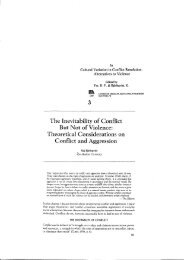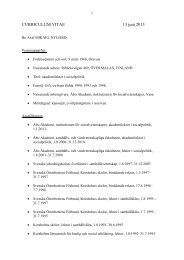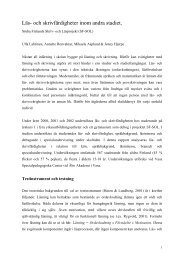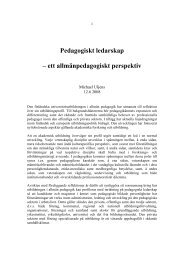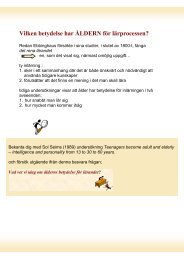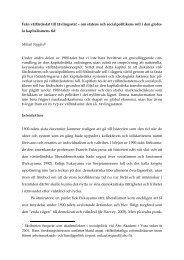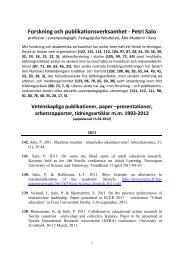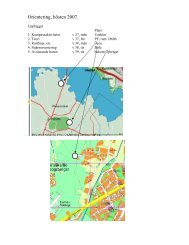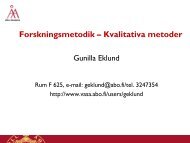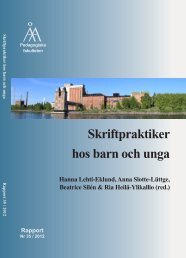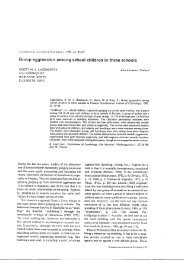Parties, Candidates and Citizens On-Line - Åbo Akademi
Parties, Candidates and Citizens On-Line - Åbo Akademi
Parties, Candidates and Citizens On-Line - Åbo Akademi
You also want an ePaper? Increase the reach of your titles
YUMPU automatically turns print PDFs into web optimized ePapers that Google loves.
of the web. Gibson et al. (2003b, 102) noted that smaller parties appear to primarily use<br />
the medium for raising awareness <strong>and</strong> organization building <strong>and</strong> tend to have a quite<br />
positive view of the medium as compared to traditional media (cf. Margolis et al. 2003,<br />
58). The ‘net gain’ might be more unclear for major parties, (cf. Sadow & James 1999, 5)<br />
<strong>and</strong> the verdict on the web less enthusiastic.<br />
Party supporters <strong>and</strong> voters<br />
The composition of the electorate is one of the main bases of a party’s strategic planning<br />
(Sjöblom 1968, 208). <strong>Parties</strong> usually divide voters according to two dimensions; whether<br />
the voter is positive, uncertain or negative towards the party <strong>and</strong> whether the voter is<br />
certain or uncertain to vote (Sjöblom 1968, 236; cf. Maarek 1995). Over time, the group<br />
of uncertain voters, both in terms of party preferences <strong>and</strong> voting propensity, has<br />
widened at the expense of the reliable voters. <strong>Parties</strong> now seek votes from many different<br />
social segments <strong>and</strong> not solely from one ‘reliable’ segment (Kirchheimer 1966; Swanson<br />
& Mancini 1996). Maarek (1995, 39) has identified two types of party communication<br />
depending on the intended audience; maintenance <strong>and</strong> conquest communications. A party<br />
seeks to maintain its supporters, both loyal <strong>and</strong> uncertain, <strong>and</strong> to gain new voters from<br />
the uncertain voter segments <strong>and</strong> the uncertain voters of other parties (cf. Rohrschneider<br />
2002). Sjöblom (1968, 208) calls these voter groups the “intended influence objects”<br />
towards whom parties focus their communication.<br />
Pertaining to party internet strategies <strong>and</strong> activity, the composition of a party’s<br />
supporters <strong>and</strong> potential voters can also be perceived as influencing if <strong>and</strong> how a party<br />
campaigns on-line (cf. Herrnson & Stokes 2003; Ward et al. 2005, 11). The concept of the<br />
‘digital divide’ has been used to describe the uneven access to <strong>and</strong> usage of the internet by<br />
citizens (Norris 2001b). The public’s internet usage tends to follow certain demographical<br />
patterns; white, young, highly educated, white-collar males use the internet at a higher rate<br />
than other citizens (Norris 2001b; 2002). A party whose “intended influence objects” do<br />
not belong to these ‘wired’ segments of the public, for instance a pensioners’ party (cf.<br />
Gibson et al. 2003b, 102), has few incentives for moving on-line in catching uncertain<br />
voters. It seems likely that such a party puts little planning <strong>and</strong> effort into a party website<br />
(Nixon et al. 2003, 241). Other parties, such as the Greens (Ward et al. 2005, 6), have<br />
their target audience amongst those social groups who use the internet most frequently<br />
<strong>and</strong> have strong incentives for making the most of their website. Of course, it is also<br />
necessary to realize that party websites may be used for maintenance communication as<br />
well; one of the potentially important functions of a party website would therefore also be<br />
to strengthen the internal organization (Gibson et al. 2003b, 87; Römmele 2003, 9). A<br />
party lacking a primary on-line audience in terms of potential voters may still put planning<br />
91



